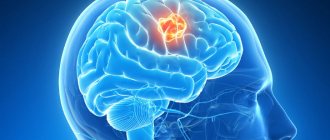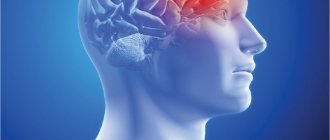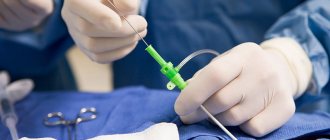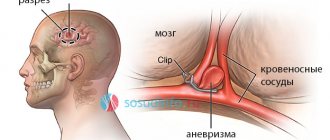Cerebral edema occurs against the background of blood circulation disorders caused by various diseases or functional abnormalities.
- Cerebral edema: prediction and symptoms
- Symptoms of swelling from hemorrhagic stroke
- Symptoms of swelling from ischemic stroke
- Cerebral edema from stroke and its features
- Reasons for development
- Care and rehabilitation
- Boarding houses for post-stroke patients "Olympia House"
The pathological condition has its consequences and can even lead to death; depending on the symptoms, it helps to determine the type of stroke suffered.
If even minor signs are detected and there is a suspicion of the formation of edema, it is necessary to arrange a visit to the doctor. An emergency call will help diagnose the condition of an elderly patient and promptly provide the necessary assistance, provide decent care and concern.
Cerebral edema: prediction and symptoms
Stroke is defined by medicine as a circulatory disorder and this condition leads to oxygen starvation of a certain area of the brain. Cortical cells die, and the patient's condition worsens due to the accumulation of watery secretions that put pressure on certain brain centers.
Watery accumulations are not capable of causing physical harm to soft tissues, but they accumulate in areas of nerve cells. This effect provokes an increase in intracranial pressure, which affects intracranial hypertension, the consequences of which (without providing the necessary assistance) become fatal.
With cerebral edema, a high degree of severity of the consequences of a stroke is determined, because this can cause unstable brain activity. The irreversibility of the impact is determined by real indicators of the extent of the spread and localization of edematous activity.
Without certain knowledge and understanding of the clinical picture, it is impossible to identify the symptoms of a pathological condition. The most difficult cases are considered to be attacks of hemorrhagic stroke, in which cerebral edema develops rapidly, putting the life of an elderly person in serious danger.
Symptoms of swelling from hemorrhagic stroke
There are many risk factors on the basis of which one or another type of pathological condition develops.
Hemorrhagic stroke is often characterized by the release of internal fluid with characteristic hemorrhage and health complications, with pronounced symptoms:
- disturbance of speech functions and functioning of muscle tissue;
- decreased limb control and facial paralysis;
- temporary loss or weakening of vision and hearing, extraneous noise;
- manifestations of swelling of the limbs and fainting, memory loss.
With a hemorrhagic stroke, there is a rapid impact on the brain and its tissues, nerve cells. The consequences of such exposure may be irreversible, therefore, if these symptoms are recorded, it is necessary to seek help as quickly as possible, providing the person with professional care and rehabilitation.
What are the risks of surgery?
According to the results of international studies, the proportion of possible complications after this operation, including fatal ones, should not exceed 3% (see the essence of the problem).
Who will perform the operation on me?
The operation will be performed by a team of doctors from the NT-Medicine clinic and nurses led by cardiovascular surgeon Sergei Vyacheslavovich Terebinov.
What is the doctor's experience?
Experience in cardiovascular surgery since 2010. More than 200 operations on the carotid arteries were performed under local anesthesia, the percentage of transition to general anesthesia when indicated was less than 2%, mortality was 0% , and the percentage of strokes after surgery was 1.0%.
These more than 200 patients include 36 patients with previous strokes , including those with “ large” brain cysts 3 , 12 cases after stroke less than 7 days from its development , 3 cases after transient ischemic attack , 1 case of bilateral carotid endarterectomy with a period 7 days between operations, 2 operations for “kinking” (kinking syndrome) of the internal carotid artery.
This group does not include patients for whom vascular surgeon Sergei Vyacheslavovich Terebinov, in addition to removing atherosclerotic plaques from the carotid arteries, simultaneously performed heart surgery - coronary bypass surgery (15 patients, two of them - coronary bypass surgery on a beating heart) or operations to restore blood flow in arteries of the lower extremities – 11 cases.
What are the disadvantages of surgery under local anesthesia?
In addition to the above advantages, local anesthesia on the neck also has a number of understandable but controllable disadvantages: many patients do not want to “be present” at the operation.
We understand your excitement and experiences during the process of removing an atherosclerotic plaque - you will hear “how the operation is going,” however, all these unpleasant moments for you are compensated by a significant increase in the safety of surgical intervention, which is what our team is striving for, and what, I am sure, you want and you!
During surgery, pain may occur in the area of the surgical wound. The operating surgeon knows about most of them at one or another stage of the operation in advance and will add an anesthetic solution in advance; we must not forget about the individual characteristics of the body - if discomfort occurs during the operation, let us know - our team will respond immediately.
Symptoms of swelling from ischemic stroke
An acute ischemic condition leads to a functional disruption of the normal reproduction of metabolic processes in neuronal cells.
Their intermediate area is filled with intracellular fluid, which leads to an increase in pressure and the formation of swelling, which has its own symptoms:
- acute headache that cannot be relieved even with strong medications;
- the appearance of vomiting and increased feeling of nausea with frequent convulsions;
- temporary disturbance of spatial orientation and feeling of loss;
- severe shortness of breath without any exertion or physical activity in patients;
- fainting and fainting, a visually determined disturbance of blood circulation.
In ischemic stroke, cerebral edema develops gradually and there is a high probability of prompt provision of the necessary assistance. At a certain level of diagnostic complications, it is important to organize constant monitoring of older people at risk.
How to treat
Treatment of stroke consists of basic therapy, including general medical measures, regardless of the type of stroke. They are aimed at ensuring optimal hemodynamics, prevention and treatment of breathing disorders with correction of oxygenation levels and the main parameters of homeostasis.
“Specific therapy includes reperfusion therapy: drug thrombolytic therapy (thrombolysis); thromboextraction: mechanical removal of a blood clot using special devices,” notes the specialist.
Cerebral edema from stroke and its features
The edematous condition is associated with quite serious consequences that may not appear immediately after a stroke. Depending on the location of the lesion, the degree of consequences and dysfunction of internal organs, the central nervous system, and the brain is determined.
Without rapid remission, which occurs thanks to good health and comprehensive rehabilitation, this condition can provoke irreversible consequences.
A severe intracranial complication associated with disruption of the central nervous system provokes the following consequences:
- distorted facial expressions;
- chronic headaches;
- limited movement;
- weakening of the sensory organs;
- deterioration of mental abilities.
After a stroke and cerebral edema, older people need to be re-taught to live and perform the usual activities for each person. To do this, it is necessary to provide him with complete rehabilitation, surround him with attention and care, and guarantee targeted medical care.
Reasons for development
Disruption of blood microcirculation in brain tissue stimulates the formation of a state of oxygen starvation.
This leads to cell necrosis, and intracellular fluid enters the cavity of the free space of the skull; brain edema can be caused by a number of reasons:
- stroke and fluid accumulation in the localization of nerve tissue;
- surgery with edema provoking coma;
- alcohol dependence and accumulation of toxic substances in tissues;
- a specific reaction of the body to a specific allergen.
Cerebral edema occurs in people of different ages, but those at risk are those whose age has exceeded 60-65 years. That is why it is important to organize constant supervision for an elderly relative with poor health, conduct regular medical examinations and strictly monitor his well-being.
Care and rehabilitation
To create optimal conditions for recovery after a stroke, it is better to choose a private boarding house for the elderly in the Moscow region. Specialized institutions provide recovery after timely identified cerebral edema, which helps minimize health consequences. Targeted and specific care ensures that negative impacts are reduced and conditions are created to restore the elderly person’s well-being.
Prevention of the problem
Of course, disease prevention is extremely important. “There is primary and secondary prevention of stroke. About 80% of all strokes are primary,” says the cardiologist.
The main preventive measures are as follows, the specialist notes:
1. Lifestyle changes. The patient must give up bad habits and a sedentary lifestyle, and start eating right. The diet should consist mainly of steamed, boiled and stewed dishes, low-fat dairy products, and fish. Be sure to drink about 8 glasses of water. Physical training should be age-appropriate; sometimes it is enough to add walking. It is equally important to eliminate or minimize stress, overexertion, and sleep at least 8 hours a day.
2. Blood pressure control. Achieving target blood pressure levels of 120-140 mm Hg. Art. for the upper and no more than 80-90 mm Hg. Art. for the bottom. The change must be made at the same time every day. If your readings increase, you should consult a doctor, he will select treatment and prescribe medications to stabilize your blood pressure.
3. Control of blood sugar and bad cholesterol levels.
4. Taking antithrombotic drugs if necessary. In the presence of atrial fibrillation and taking into account contraindications, it is necessary to prescribe anticoagulants.
“Secondary prevention of stroke is a set of measures aimed at reducing the likelihood of developing a recurrent stroke, including lifestyle modification, drug therapy (antithrombotic, hypotensive, hypolipidemic), and, if necessary, surgical treatment aimed at restoring cerebral blood flow in case of stenosing atherosclerotic lesions of the carotid arteries “says Olga Kozlova.
The specialist emphasizes that an individual secondary prevention program should be developed in a hospital setting within the first 48 hours of the disease after determining the pathogenetic variant of stroke.
A quarter less deaths. How people in the Russian Federation get back on their feet after a stroke Read more
Boarding houses for post-stroke patients "Olympia House"
Providing professional and qualified care for the elderly in Moscow, our network of boarding houses offers excellent living conditions.
Thanks to an integrated approach, each ward receives maximum attention to their health, medical care and constant supervision:
- conducting regular inspections;
- medical service;
- good nutrition and walks;
- development of a rehabilitation plan;
- psychological support.
The expanded network of private boarding houses for the elderly Olympia House includes a complex of nursing homes located in different regions. Using the services offered, you can choose the best conditions for elderly relatives and select a complex for rehabilitation and recovery.








